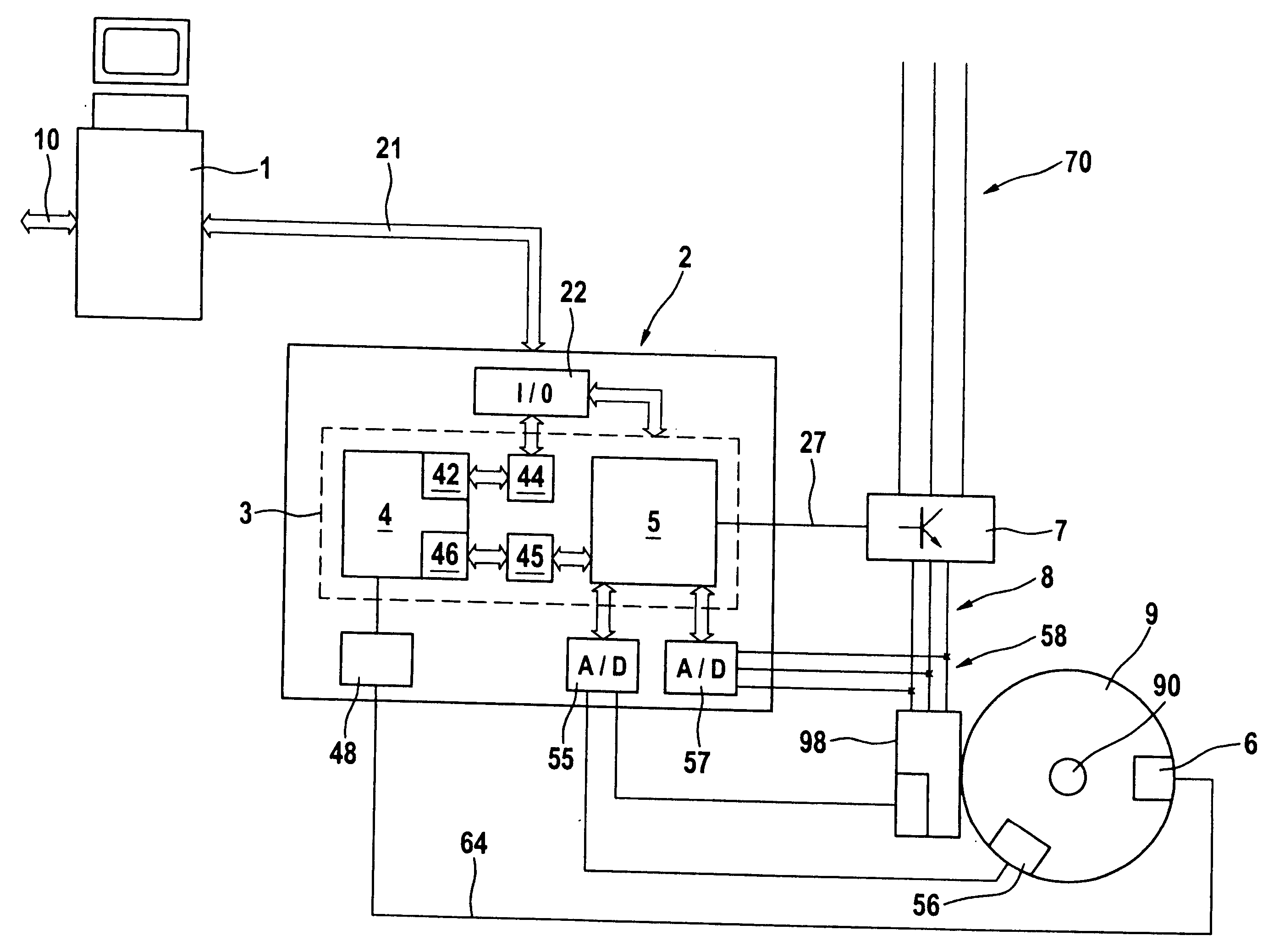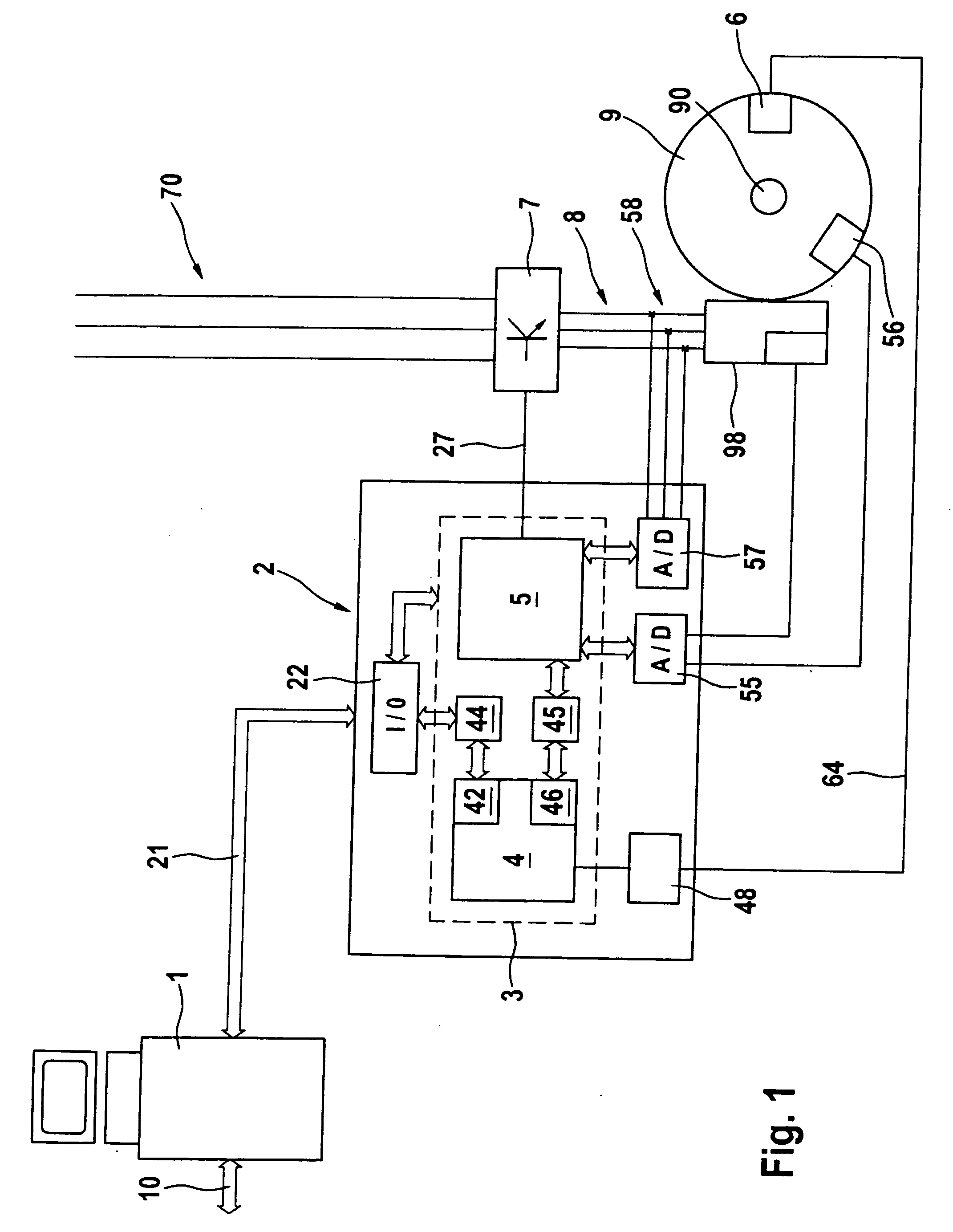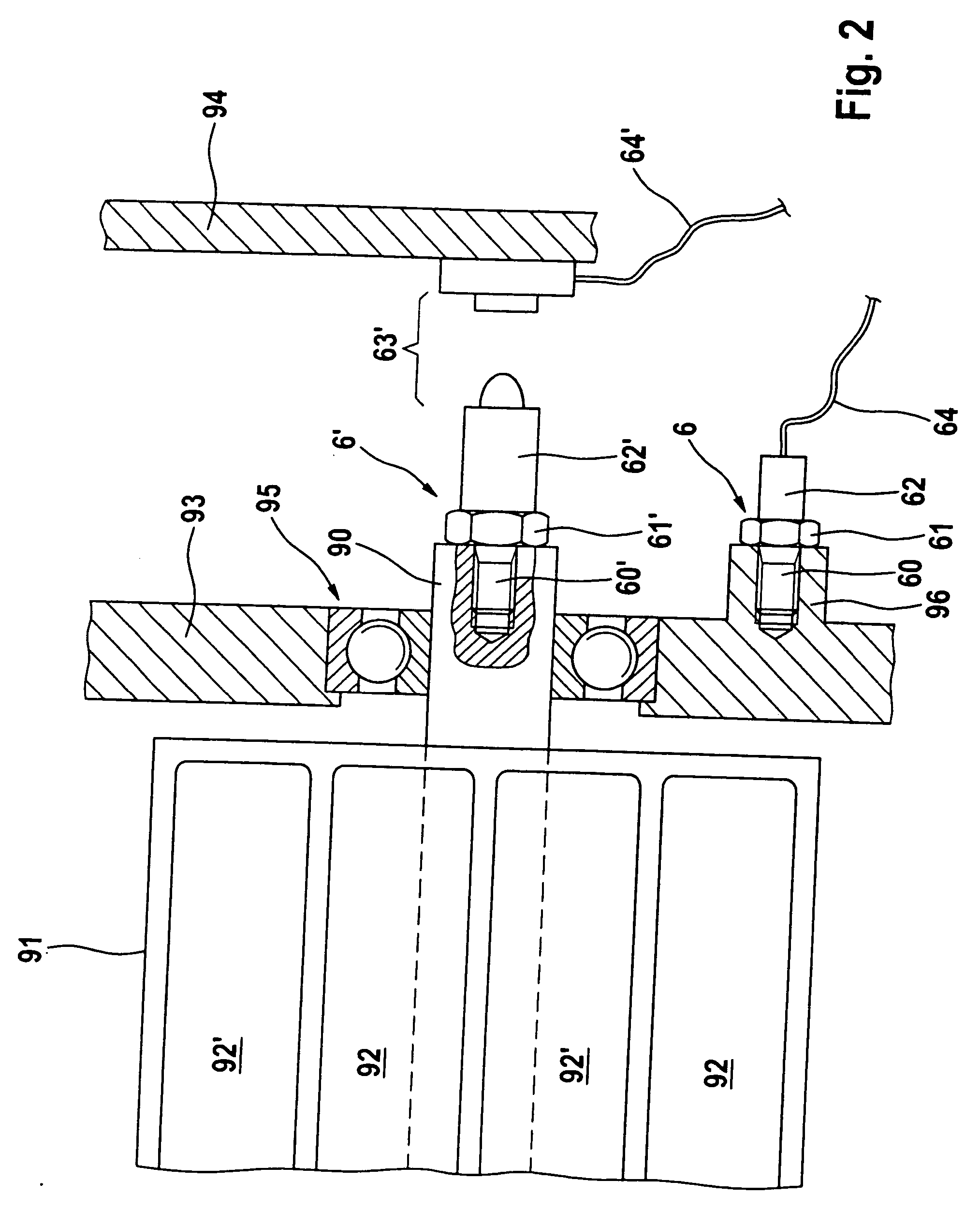[0009] The invention is based on the concept that, in the case of contemporary
electrical drive apparatuses fed by
converters, the control device generally has a powerful microprocessor in order to drive the power module in accordance with the requirements even in the case of high rotation speeds and thus to ensure precise operation of the drive apparatus. The invention has recognized that this microprocessor, which is provided in any case, can also be used for assessing the signals from the structure-borne noise sensor. The invention therefore envisages using the resource “microprocessor” of the control device for the assessment module as well. A separate microprocessor for the assessment module is thus superfluous. The additional complexity for production,
programming and incorporating a further microprocessor in the
electrical drive apparatus is thus reduced. In addition, the integration according to the invention results in advantages in terms of spatial requirement. A separate microprocessor would require additional space, i.e. a larger or additional housing. Since, according to the invention, a second microprocessor can be avoided, the emitted heat brought about by its
power loss is also lost. The
thermal load is thus reduced. Analysis of structure-borne noise signals is thus made possible for electrical drive apparatuses without substantial additional costs arising and without additional requirements for
physical space or heat dissipation being set. This makes it possible to use the structure-borne noise analysis
system even in cost-sensitive sectors and for small drive apparatuses such as
servo drives, in the case of which a low physical size is of particular importance. The integration of the assessment in the same microprocessor, which also carries out the control of the power module of the drive apparatus, also makes it possible to incorporate results from the structure-borne
noise assessment in the control of the electric motor, and vice versa. This may result in additional synergistic effects.
[0012] The structure-borne noise sensor can in principle be arranged on the electric motor or on the
machine driven by it, as previously. Owing to the integral incorporation of its assessment in the control device, however, it is possible for the structure-borne noise sensor to be fitted at another point. It has been shown that a favorable arrangement is provided within a terminal box of the electric motor. The terminal box is generally mounted directly on the motor, with the result that the structure-borne noise sensor arranged in the terminal box fuses functionally with the electric motor to form one unit. Furthermore, the structure-borne noise sensor is arranged in the terminal box such that it is protected, with the result that defects owing to
contamination and / or damage do not occur or only occur to a reduced extent.
[0013] Logic means are expediently provided which are designed to transmit measured variables and / or state variables for the converter drive module to the assessment module. Variables and parameters such as the motor currents and the motor rotation speed, which are provided in any case in the
motor control module for actual motor control purposes, can thus be transmitted to the assessment module. This assessment module is thus able to also take into account these parameters when assessing the signals from the structure-borne noise sensor. It is thus possible, for example also taking into account the
stator currents of the electric motor, to decide whether certain noises only occur when the electric motor is subjected to a load or whether they tend to occur during no-load operation or even when the electric motor is overrunning. The logic means can advantageously have
time windows. This means that assessment of the
signal from the structure-borne noise sensor is restricted to the time intervals in which the motor is running. This is particularly advantageous when averaging filters (for example moving-average filters) are used in order to avoid falsification of the average value owing to standstill times. Furthermore, this makes it possible for faults owing to cross-couplings between the operation of the motor, on the one hand, and the measurement of the structure-borne noise signals, on the other hand, to be detected easily and filtered out. For this purpose, common-mode rejection means are advantageously provided. They cause faults in the structure-borne noise signal which are brought about by the driving of the electric motor to be reduced. This results in a further improvement in the
signal quality from the structure-borne noise sensor and thus ultimately also in an improved assessment result.
[0014] The integration of the assessment module in the microprocessor of the control device, which is provided in any case, also has the
advantage that the wiring can likewise be designed in an integrated manner. Integrated will in this case be understood to mean that the signal line, which connects the structure-borne noise sensor to the assessment module, is integrated in the connecting line carrying the motor current.
Signal line will in this case be understood to mean not only the line carrying the actual measurement signal but also feed lines which may be required for the operation of the structure-borne noise sensor. The connecting line is in any case necessary in order that hardly any notable additional outlay is required for wiring the structure-borne noise sensor.
[0015] The cost-saving integration of the assessment module in the microprocessor of the control device according to the invention makes it possible to provide the electrical drive apparatuses with the structure-borne noise analysis
system without any notable additional outlay and in a
mass-produced manner. Complex
retrofitting is thus dispensed with. The
mass-production method also has the
advantage that the structure-borne noise sensor can be mounted as early as when the electric motor is produced. It is thus possible to arrange it at points which could not be reached or could only be reached with an unreasonably high degree of complexity when
retrofitting. The determination of the mounting position of the structure-borne noise sensor can thus merely take place on the basis of the quality of the measurement signals to be expected, without
accessibility needing to be taken into account when
retrofitting. The structure-borne noise sensor can be arranged on inner elements of the electric motor without any difficulty. An arrangement of the structure-borne noise sensor at bearing points is preferred. A further preferred mounting location is on a force-imparting shaft of the electric motor. It is particularly preferred for the structure-borne noise sensor to be arranged so as to concomitantly rotate with the shaft and for a
transmitter to be provided for the purpose of transmitting signals to the assessment module. It has been shown that defects usually occur on rotating components of the electric motor. By means of transmitters, the signals from the structure-borne noise sensor can be transmitted from the rotating shaft to the stationary part. The path for the arrangement of the structure-borne noise sensor on the shaft is first smoothed by the invention since this location is usually suitable for retrofitting. The reason for this is not necessarily the problematic
accessibility of the shaft, but consists in the fact that, when retrofitting, there may be problems relating to imbalance which, based on experience, can only be reliably brought under control with difficulty. Since, thanks to the invention, the electrical drive apparatuses can be provided with the structure-borne noise analysis
system with little outlay and in a
mass-produced manner, the attachment of the sensor can be taken into consideration as early as at the
design stage such that no problems relating to imbalance result, such as when retrofitting. Taking into consideration the attachment of the structure-borne noise sensor as early as the
design stage also makes it easier to arrange the structure-borne noise sensor such that it is not negatively influenced by the
centrifugal force occurring on rotation of the shaft. The structure-borne noise sensor is thus prevented from being overloaded in the event of a rapidly rotating shaft. For this purpose, the structure-borne noise sensor is preferably arranged such that its measurement direction is aligned coaxially with respect to the shaft.
 Login to View More
Login to View More  Login to View More
Login to View More 


